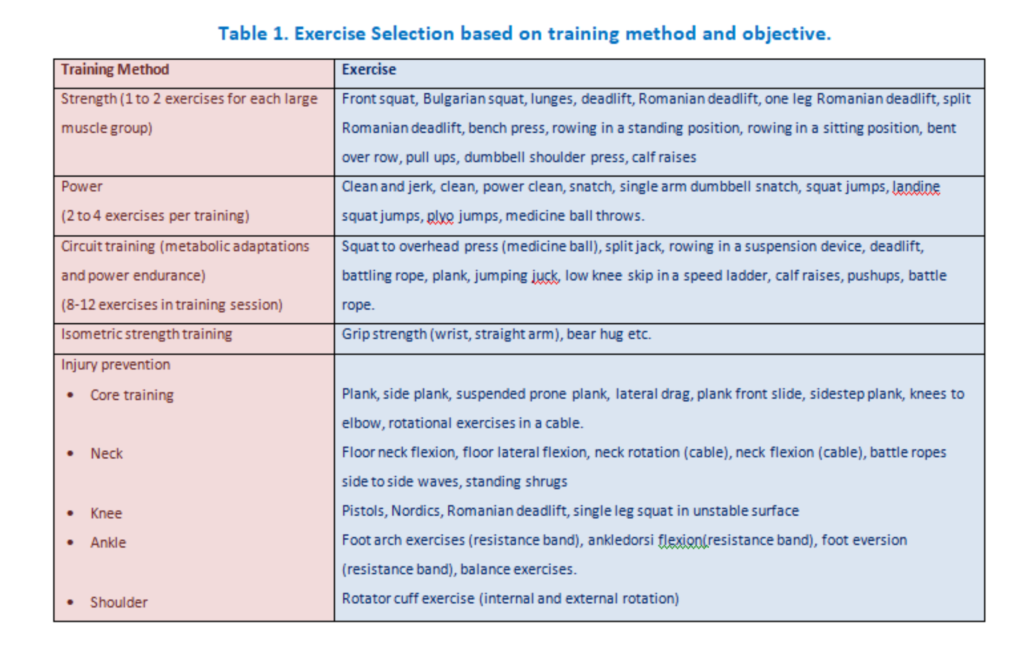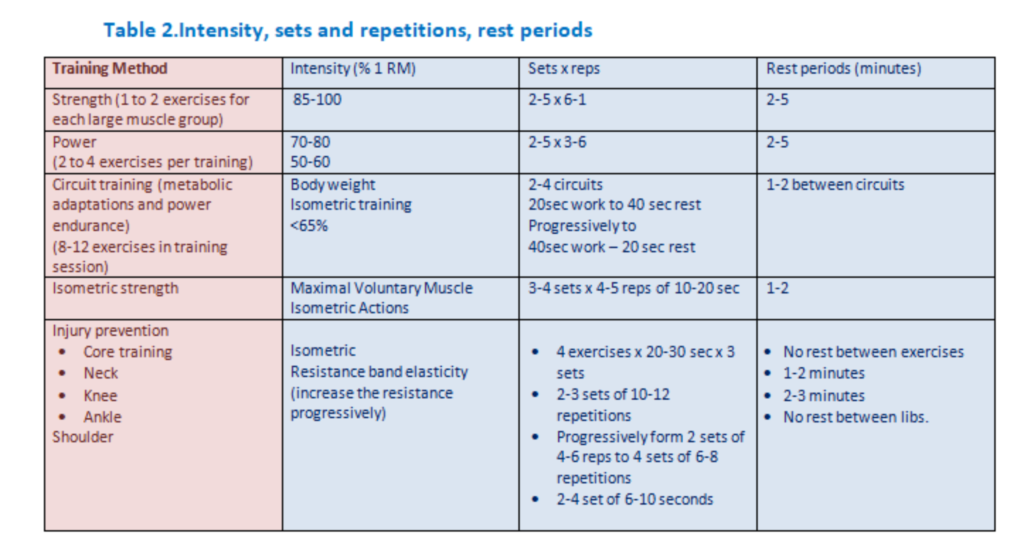
Erasmus+
“This project has been funded with support from the European Commission. This publication reflects the views only of the author, and the Commission cannot be held responsible for any use which may be made of the information contained therein”
Strength training in wrestling
Upon completion of this module the reader will be able to:
- Understand the Strength training in wrestling
- Understand the Wrestling- needs analysis
- Understand the types of strength training methods
- Understand the Exercise selection
- Understand the Intensity, Sets and repetitions and rest periods
First, it is strongly suggested to review:
American College of Sports Medicine position stand. Progression models in resistance training for healthy adults. (2009). Medicine and Science in Sports and Exercise, 41(3), 687–708. https://doi.org/10.1249/MSS.0b013e3181915670
Strength training in wrestling
Wrestling- needs analysis
Wrestling is one of the most popular sportsduring childhood, adolescence, and adulthood. Athletes participate in competitions such as Olympic games, world championships and European championships. Wrestling is divided in two styles: Grecoromanand Freestyle. In the Grecoroman style athletes areallowed to use only upper body moves, while in the freestyle they are allowed to use both upper and lower body moves. Despite the differentiation in rules, athletes are usually trained in the same way. Moreover, they are divided in weight groupsso that they can participate in matcheswith comparable athletes regarding the body size.
A single wrestling match consists of 2 three-minute rounds and in tournamentsthe athletes participate in three to four matchesonthe firstday and one to two matches onthe second day. During the matches an athlete earns points by moves such as pulls, pushs, holds,lifts, and throws fromparterreposition where large muscle groups, from both upper and lower body,are activated to produce muscle power.
Concerningthe physiology of a wrestling match, the ability to buffer the high acidic muscle seems to be a crucial factor. The acid base balance is altered because of the high intensity in exercise. Phosphagens breakdown and fast glycolysis are two metabolic pathways which support the athlete’s effort during the match and as a result increasethehydrogenions concentration in muscle and blood. Furthermore, participation in many games ona single day inducessignificant physiological demands which affect the athlete’s performance andexercise induced inflammatory status.
High physical demands of wrestling resultinan increasedpossibility of musculoskeletal injury occurrence (approximately 3 injuries per athlete in a year and 13 injuries per 1000 hours). Wrestlers are commonly injured in lower extremities, upper extremities, trunk, and neck area. Specifically, common instances of musculoskeletal injuries are in the lumbar and sacral area of the vertebral column, knee, shoulder, neck, and ankle. Factors which affect the injury occurrence possibility and the severity of injury are the wrestling style (freestylers experience more injuries in lower extremities), the sex (female athletes have higher rates of injuries than male athletes)and the training period (in body weight reduction period athletes are exposed to higher risk).
Participation in a well-structured strength training program may induce favorable adaptations in maximal strength, muscle power, endurance of muscle power, body composition and may also reduce the possibility of a musculoskeletal injury occurrence and/or the severity of injury. An optimization of the strength training type, strength training method, exercises,intensity, volume and rest periods should be establishedfor each training objective. Furthermore, the training should be designed in accordancewith the training period.
Types of strength training methods
Demands of wrestling indicate the need of strength, power, muscle power endurance and body composition optimization. Methods of strength training which should be involved in a program design arepower training through resistance, ballistic and plyometric training, circuit resistance training and injury prevention training. Furthermore, the isometric training of arms and torso enhances wrestlers’ performance and canbean effective injury preventive strategy.
Exercise selection
The selection of strength exercises should be based on body site and training objective. In Table 1.
Table 1. Exercise Selection based on training method and objective.

Intensity, Sets and repetitions and rest periods
The intensity of resistance exercise depends on each training phase, the athletes’ needs analysis and the training method. In general, during strength training the intensity varies form 85-100% in terms of one repetition maximum (RM), in power 50-60% of 1 RM in strength type of exercise and 55-60% of 1 RM approximately in lower extremities velocity-basedtraining and30-40% of 1 RM in upper extremities velocity-based training. However, for a better intensity establishment of intensity in power training, aforce velocity curve should be developed for each athlete. In circuit training athletes the body weight or a small amount of resistance should be used.
The total number of sets and repetitions in strengthtraining is linked tothe training goal. In strength and power training a small number of powerful repetitions is the main target. On the other hand, in muscle endurance and hypertrophy,a high number of repetitions is needed. For instance, in strength and power training two to five sets of six to one repetitionand 3-6 must be performedrespectively for strength and power. In circuit training 8-12 exercises must be selected and the athletes should perform 2-4 cycles in which 15-20 repetitions (one repetition in isometric exercise such as plank) are executed in each exercise. Otherwise, exercise to rest ratio (work-to-rest ratio)of 20:40 which progressively be 40:20 could be used in circuit training process.
Rest periods between sets are large (2-5 minutes) in strength and power training. On the other hand rest periods of <1 minute to 2 minutes are utilized in circuit and hypertrophy training.

Strength training session
Typically, in the strength training session the period of warm up, the strength training for whole body or split routines and finally the cool down period are organized. It is suggested thatthe warm up period in wrestling shouldconsist of 5-10 minutes low intensity aerobic mode of training which should be followed by dynamic stretching and strength activities. The total duration of the warm up period before strength training session should properly last about 20-25 minutes. During the Warm-up session, athletes could perform muscle activation protocol (core and ankle muscles see Tables 1 and 2) and injury prevention exercises as described in Tables 1 and 2. For strength training it is recommended to design different training sessions with specific goals. Particularly, it is suggested to design a strength training session, a power training session and a circuit strength training. The sequel of training sessions should be determined in periodization.
Frequency of strength training.
The frequency of strength training depends on the training status (novice, intermediate or experience athlete), training period (preparatory, competition or transition period) and the whole training program. Generally, it is suggested to design training sessions of unique training goal and training sessions apart approximately 72 hours. Duringthe preparatory period, strength training frequency would be twiceor three times per week, during thecompetition period twice per week, during the last 10 days before competition frequency of strength training should be designed in conjunction to body weight reduction strategy and should be characterized by reduced volume. The transition period is a window of opportunity to design strength training sessions to treat any limitation of athletes. This period is divided in the first and second phase. In the first, transition strength training frequency is possibly increased and muscle split training (not always) may be designed to treat specific athletes’ limitations. During the second phase of transition period,a performance improvement training session is designed and the athletes participate approximately three times per week in strength training sessions.
Periodization of strength training
Regularly, European athletes participate in two major competitions per year which are time apart almost five months. So, coaches usually design biannual training programs. The athletes participate twice per year in a preparatory, competition and transition training process. Strength training follows the general structure of training program and is divided in the same periods. Strength training programs could be designed based either on a nonlinearor linear strength training periodization model. The selection of the periodization model depends on the training status. For example, a novice and/or adolescent athlete, in strength training, will advantage form both training models. On the other hand, for an experiencedathlete it is preferable to participate in a non-linear periodization model which is possibly better for longer periods. In a linear model, strength and conditioning coaches design periods of endurance and hypertrophy training for some weeks or months (depending on the athletes’ training status) and then training for strength, power, and endurance in power activities during the competition period. The special period in wrestling is the last two weeks before the participation in a major competition. Unfortunately, unpublished investigation concluded that athletes’ primary care to reduce their body weight by using intense methods (sauna, nutrition eth.) can negatively affect their performance and increase the possibility of musculoskeletal injury. Strength training should be designed in accordance withthe athletes’ individual needs and the whole training program design. Optimally, an athlete should be participating in two to three training sessions during the last ten days before competition (as an example: circuit training in day 10 before competition, strength training in day 7 and power training in day 3). In a nonlinear training process, strength and conditioning coaches design three to four different program periods. In all periods, strength training includes circuit, strength, power, and power endurance training sessions. The selection and the frequency of each training session is based on the corresponding period. In the preparatory phase, circuit training and strength trainingshould appear many times in the program, while power and power endurance should occur many times in the competition period. The periodization of strength training provides significant information for both coaches and athletes and acts as a compass for them. However, periodization should be an individual process and not only strength training methodsbut also other program variables (frequency, intensity, volume and rest period) can be implemented to optimize the training results.
Bibliography and the additional learning materials
Strength training:
- is necessary to optimize wrestling performance
- functions asan effective injury prevention strategy
- should be designed for the whole year training plan
- should be designed in the form of individually training plans
should be in accordance with the periodization process.
American College of Sports Medicine position stand. Progression models in resistance training for healthy adults. (2009). Medicine and Science in Sports and Exercise, 41(3), 687–708. https://doi.org/10.1249/MSS.0b013e3181915670
Barbas, I., Fatouros, I. G., Douroudos, I. I., Chatzinikolaou, A., Michailidis, Y., Draganidis, D., Jamurtas, A. Z., Nikolaidis, M. G., Parotsidis, C., Theodorou, A. A., Katrabasas, I., Margonis, K., Papassotiriou, I., & Taxildaris, K. (2011). Physiological and performance adaptations of elite Greco-Roman wrestlers during a one-day tournament. European Journal of Applied Physiology, 111(7), 1421–1436. https://doi.org/10.1007/s00421-010-1761-7
Fleck, S. J. (2011). Non-linear periodization for general fitness & athletes. Journal of Human Kinetics, 29A, 41–45. https://doi.org/10.2478/v10078-011-0057-2
Issurin, V. B. (2010). New horizons for the methodology and physiology of training periodization. Sports Medicine (Auckland, N.Z.), 40(3), 189–206. https://doi.org/10.2165/11319770-000000000-00000
Kim, J. C., & Park, K. J. (2021). Injuries and rapid weight loss in elite Korean wrestlers: an epidemiological study. The Physician and Sportsmedicine, 49(3), 308–315. https://doi.org/10.1080/00913847.2020.1824536
Kraemer, W. J., Vescovi, J. D., & Dixon, P. (2004). The Physiological Basis of Wrestling: Implications for Conditioning Programs. Strength & Conditioning Journal, 26(2).
Kukidome, T., Shirai, K., Kubo, J., Matsushima, Y., Yanagisawa, O., Homma, T., & Aizawa, K. (2008). MRI evaluation of body composition changes in wrestlers undergoing rapid weight loss. British Journal of Sports Medicine, 42(10), 814–818. https://doi.org/10.1136/bjsm.2007.044081
Pirruccio, K., Hoge, C., & Kelly Iv, J. D. (2020). Comparison of in-season and off-season wrestling injuries presenting to United States emergency departments: 2000-2018. The Physician and Sportsmedicine, 1–6. https://doi.org/10.1080/00913847.2020.1865780
Thomas, R. E., & Zamanpour, K. (2018). lnjuries in wrestling: systematic review. The Physician and Sportsmedicine, 46(2), 168–196. https://doi.org/10.1080/00913847.2018.1445406
[ays_quiz id=’30’]
Erasmus+
“This project has been funded with support from the European Commission. This publication reflects the views only of the author, and the Commission cannot be held responsible for any use which may be made of the information contained therein.”
